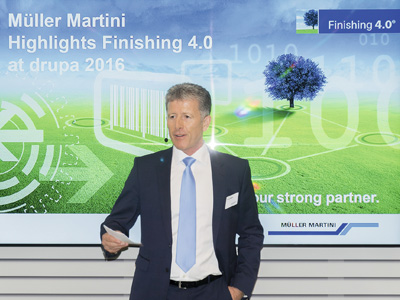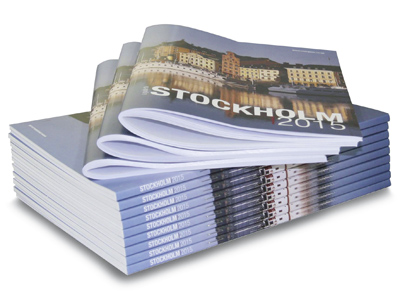Morgana highlights the benefits of “squareback” binding
Digital printing of books triggered an ongoing revolution, so the binding stages have had to adapt to short runs, single copies, and on-demand ordering. Simon Eccles leafs through the options.
Even when a big full-time book printer is still turning out tens of thousands of books per day, it’s increasingly rare for there to be thousands of the same title at a time, except for mass-market bestsellers. Publishers are more likely to order a few hundred books, see how they sell, and run up to thousands if the market responds.
Established mass production bindery manufacturers such as Muller Martini, Kolbus, and – for the past five or six years – Hunkeler, have responded to the digital print market by developing fast-reacting fully automated size change systems in their feeding, folding and binding lines. They still turn out several thousand finished books per hour, but every book can in principle be a different size.
What usually happens is that book runs are grouped in set of books all with the same cover face size, but the number of pages, and therefore block thickness, is varied frequently.

Kolbus’s KM 200 perfect binder is described as “zero makeready” and handles up to 5000 cycles an hour
Robert Flather, managing director of Kolbus UK says ‘What we’re moving to is books of one done on an industrial basis. You’ve already got small binders doing runs of one. But what we’ve got is our KM 200 line with 27 clamps, also doing runs of one. The beauty is that you can do a run of one or a run of 100,000 on the same machine. The speeds of traditional binders are now coming to the very short run markets as well.’
Even batching will die out, he predicts. Identifying and sorting orders of several books for the same book shop that have been grouped by size takes far longer than simply producing the whole order at once. ‘You lose a little in speed of production, but you save more time in organisation and labour costs,’ he says.
Finishing 4.0
The increasing use of motorised and automated adjustments brings the binding sector into line with a technical movement that the Germans have labelled Industrie 4.0. This says that the combination of robotics, computer controls, process automation and data analytics all combine to make a ‘fourth industrial revolution’ (the first three being steam power, electricity and computers). There was a lot of that being mentioned at last year’s drupa, variously labelled Print 4.0 and Finishing 4.0.

Bruno Müller introducing his company’s take on Finishing 4.0 at drupa last year
Müller Martini in particular made Finishing 4.0 a large part of its drupa message. At a press conference, CEO Bruno Müller said that Finishing 4.0 includes ‘automation, connectivity, variability, touchless workflow and hybrid systems processing both offset and digitally printed products. We optimally coordinate those and ideally enable a touchless workflow, allowing graphic arts businesses to keep their production costs low despite shorter runs and increased product variety.’
Hunkeler’s Modular Book Solution is also very much in the spirit of Finishing 4.0, creating glued book blocks inline or off-line from the output of continuous digital printing systems up 762mm wide, at up to 200m/min. At this year’s Hunkeler Innovation Days event in Switzerland, companies lined up to show automated finishing lines that ran inline or near-line to digital presses. Among other things Hunkeler showed a new (actually reintroduced) Fly Folder that can produce four- or six-page sections without stopping, then running into the book block gluer.
Hunkeler also showed off a robot arm to take unglued book blocks off a conveyor leading from a Hunkeler unwinder and sheeter, and transferring them in the correct orientation to a Müller Martini Vario perfect binding line followed by an InfiniTrim three-knife trimmer [see also our report on the Hunkeler event in Digital Printer March. A similar demonstration was made with a Horizon BQ-480 binder.
Apart from Hunkeler, Friedheim is also agent for the UK-made IBIS Integrated Bindery Systems, whose Smart-Binder wire/glue stitching systems and various add-ons can run inline or near-line with digital presses. ‘It makes no difference from our point of view whether the press is toner or inkjet,’ says IBIS managing director John Cracknell. ‘We mostly deal with inkjets as they run at high speed and that’s what we do too.’
The Smart-Binder can handle trimming, cover feeding and saddle stitching. Particularly noteworthy is the ISG gluing system that holds folded sheets together with beads of glue instead of wire stitches. IBIS offers configurations with stitchers, gluers or both together. At the Hunkeler event, IBIS ran a SB-3 ‘Plus HS’ inline with a Domino K630i mono inkjet book printer plus a Hunkeler sheet cutter and variable plough folder.
Manroland Web Systems is a name usually associated with presses, but it has developed a pair of high capacity inline digital print finishing modules, FoldLine and FormerLine, announced at drupa 2012. It’s installed 15 of these worldwide, 12 for full-time book production.
FoldLine is a pin folder mainly intended for newspaper plants that fill the capacity between editions with magazine or even book work. Full-time book printers are offered the FormerLine, a dedicated inline ‘reel to book block’ folding, cutting and collating system. It’s suited to high volume runs containing same-size batches from one to several thousand copies with no interruption. When size changeovers are needed they are pre-set to take as little as 15 seconds. Speeds are up to 300m/min, or 250m/min if glued. There’s a wide choice of section sizes and formats on web widths up to 1060mm and paper weights from 40 to 120gsm.

Duplo’s DuBinder DBP-500 – a fully automatic single-clamp design than can
handle 525 books an hour
Low to mid-range binding
So far we’ve considered high end, high capacity binding lines for full-time book printers. However, a lot of smaller general printers are happily offering books as part of a range of products, produced by their sheet-fed toner presses. Over time they may adopt sheet-fed inkjets.
A lot of sheet-fed digital presses offer inline finishing units of surprising sophistication – the phrase “booklet-making” may evoke A5 parish magazines, but some of them are books by any other name.
There’s often a question of whether to run finishing systems inline with the press, which is efficient and labour-saving, or near-line, which is more flexible as the output from several presses can be fed through. CP Bourg squares this circle with its Digital Sheet Feeder, which fits inline with a press but can also accept carts holding palettes of printed sheets from other presses.
Finishing makers have responded well to the challenges and opportunities of digital printing at the small to mid-volume scales. Companies such as CP Bourg, Duplo, Morgana, Wohlenberg (distributed by Friedheim) and Horizon have developed ranges of affordable systems with motorised set-ups and job memories, often with zero makeready so the first item is sellable.
PUR glue is often required for digital toners and glossy papers, though hotmelt EVA is still relevant as it cures virtually instantly. For example, Duplo offers three levels of PUR binder, all with closed tanks for easier cleaning, to serve low, medium and “heavy duty” volume requirements. It also has two levels of EVA binder. Similarly, Morgana offers the DigiBook line of sealed-tank PUR or EVA single-clamp binders, offering four models with speeds ranging from 150 to 450 cycles per hour.
IFS offers the extensive range of perfect binders made by Horizon, with single-clamp and four-clamp models in a range of sizes and speeds. For example the BL-480 single-clamp model is available with PUR (1000 cycles/hour) or EVA (1350 cycles/hour). It can produce up to 800 books of one per hour.
Terry Cooper Services has recently introduced the Premier 435 Auto to the range of perfect binders it distributes (which also include the Digital Robot range). This is a single-clamp model for volumes of 300 to 450 books per hour. It can also function as a standalone creaser.
Perfect Bindery Solutions is distributing the Risetec BRM perfect binder, covered in Digital Printer in the past. This is a flexible and automated machine that can produce either perfect-bound books or blocks bound by end papers ready for casing-in. PUR spine gluing is combined with EVA side gluing. Single-, four- and 16-clamp models are offered. This is now marketed worldwide by IML Machinery, an Italian components supplier for Risetech that has invested in the company. The first installation has been made in Belgium.
Stitching and SquareBack
Normally for books above about 3 to 5mm thick (say around 65 sheets) it’s generally preferable to perfect bind or case bind books rather than saddle stitch them, otherwise they won’t close flat. However, the SquareBack system pioneered by Watkiss Automation allows thicker books to be stitched by forming the spines to be flat, so the book closes perfectly (and incidentally can show a title on the spine). The quoted maximum book thickness is 8mm, or about 160 pages of 80gsm.
Watkiss makes SquareBack systems that can run inline or near-line to sheetfed presses, and also licenses the technology to OEM inline finishers. Last year the high volume modular Watkiss PowerSquare 224 SquareBack book maker was joined by the 160 model, aimed at mid-volume users. Also new was Mamo SQ 320, an entry level hand-fed booklet maker that forms a square spine on booklets of up to 30 sheets in formats including A4 landscape.
Book binding today is highly innovative and taking full advantage of advances in automation and robotics, which are available at the entry level up to high volume work. We haven’t heard the last of Finishing 4.0.
Read the full August issue here





